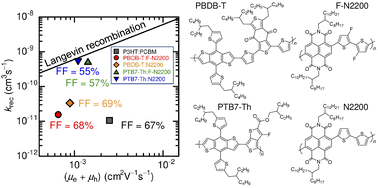Chain aggregation dictates bimolecular charge recombination and fill factor of all-polymer blend solar cells†
Abstract
One of the bottlenecks in improving power conversion efficiencies of all-polymer blend solar cells is the low fill factor (FF), along with the intolerance to film thickness. In this study, we examined the behavior of charge-carrier extraction and recombination to determine the key factors that improve or limit the FFs of all-polymer blend solar cells. We conducted space-charge-limited current mobility, electrical impedance spectroscopy, and grazing-incidence wide-angle X-ray scattering measurements for four exemplary all-polymer blend devices composed of a naphthalene diimide-based low-bandgap polymer acceptor. The high charge-carrier collection ability and, thus the high FF of ∼70% of the all-polymer blends result from the long charge-carrier lifetime due to small bimolecular recombination coefficients. The degree of suppression of the bimolecular charge recombination is quantified using the Langevin theory and is then related to the blend morphology of the device. Consequently, we conclude that the preferred blend morphology for suppressing bimolecular recombination is characterized by a well-ordered local structure due to chain aggregation by both the polymer donor and acceptor. This study guides future research efforts toward the development of thickness-tolerant all-polymer-blend solar cells with high FFs.



 Please wait while we load your content...
Please wait while we load your content...